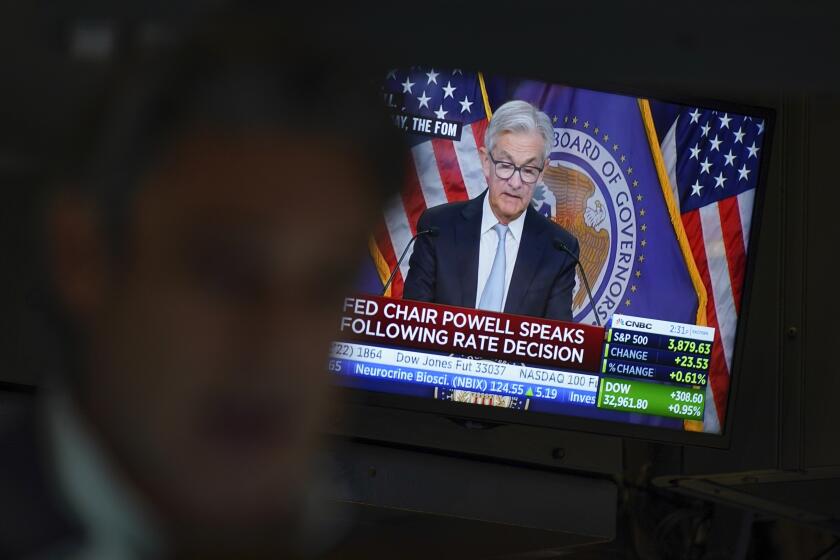Wall Street rallies on rate hopes, notches gain for the week

- Share via
Stocks rallied after a shaky start and closed with broad gains Friday as some mixed readings on the U.S. economy stoked hope on Wall Street that inflation may keep cooling and the Federal Reserve may ease up on its interest rate hikes.
The Standard & Poor’s 500 rose 2.3%, marking its first winning week in the last five. The Dow Jones industrial average gained 2.1% and the Nasdaq composite added 2.6%. Small-company stocks also rose, lifting the Russell 2000 index 2.3% higher.
Markets worldwide got an initial jolt from the U.S. jobs report. On the upside for them, it showed workers’ wage gains are slowing, which could mean easing pressure on the nation’s high inflation. On the downside, it also showed hiring across the job market may still be too strong for the Fed’s liking, even after its fusillade of rate hikes last year.
Analysts warned trading may remain turbulent in the coming hours and weeks as investors keep trying to handicap whether the economy can avoid a recession. Much of the trading is based entirely on expectations for what the Fed’s future rate hikes: Higher rates slow the economy by design, hoping to grind down inflation, while also threatening to cause a recession and dragging down prices for all kinds of investments.
Perhaps the clearest action for investors was in the bond market, where yields for the two-year Treasury fell to 4.28% from 4.48% just before the release of the data on wages.
Federal Reserve officials affirmed their intention to lower inflation back toward their 2% target at the risk of rising unemployment and slower growth.
That yield tends to track expectations for Fed action, and some investors are increasing bets that the central bank will dial down the size of its next rate hike following Friday’s data on the economy.
Key for them is the reading showing wages for workers across the country rose 4.6% in December from a year earlier. It’s the smallest raise for workers since two summers ago, and it came despite economists’ expectations for an acceleration.
While weaker raises hurt workers, particularly when they’re still not keeping up with inflation, economists say they could keep the economy out of a vicious cycle where big gains in pay push employers to raise prices for their own products, leading to even higher inflation. It’s something the Federal Reserve has talked about preventing, part of the reason why it’s been hiking interest rates at economy-shaking speed.
“As long as wage gains are coasting to a sustainable altitude, the Fed might continue to throttle back its rate hikes,” said Brian Jacobsen, senior investment strategist at Allspring Global Investments.
A separate report also showed that activity in the U.S. services industries contracted last month for the first time since 2020. Analysts said that’s likely due in part to the rate hikes already pushed through by the Fed, and the weakness could reduce pressure on the nation’s inflation.
That report helped steady the stock market following a shaky morning and sent it ripping higher again. After opening the day with an initial pop of 1.2%, the S&P 500 lost almost all of it within minutes as Wall Street struggled with how to interpret the U.S. jobs report and what it means for the Fed and rates.
The Fed has pulled its key overnight rate up to a range of 4.25% to 4.50% after it began last year at virtually zero.
With inflation showing some signs of cooling in recent months, the Fed last month stepped down the size of its rate increase to .5 percentage points from four straight hikes of .75 points. Traders are largely betting on the Fed to move to the more traditional hike of .25 points at its meeting next month.
Regardless of the size of rate increases the Fed elects to go with at the next couple of policymaking committee meetings, Wall Street is expecting the central bank to hit the pause button on rate hikes after March, said Sam Stovall, chief investment strategist at CFRA.
“Our belief is that they will start to cut interest rates in December 2023, even though they currently say they’re not looking to cut rates this year,” Stovall said. “The weakness in the economic data will tell them that they should and the decline in the inflation data will tell them that they can.”
Past rate hikes have already meant big pain for areas of the economy that do best when rates are low, such as housing.
In coming weeks, companies across industries will show how widespread the damage is when they report how much profit they made during the last three months of 2022.
If companies across the S&P 500 report a drop in overall earnings per share, as some analysts suspect, it would be the first decline since the summer of 2020.
On Friday, retailer Costco Wholesale jumped 7.3% for one of the biggest gains in the S&P 500 after it reported stronger sales for December.
The market’s gains were widespread Friday, with about 95% of the stocks in the benchmark S&P 500 index closing higher. Technology companies powered much of the rally. Chipmaker Nvidia rose 4.2%.
The S&P 500 closed 86.98 points higher at 3,895.08. The Dow added 700.53 points to finish at 33,630.61, while the tech-heavy Nasdaq rose 264.05 points to 10,569.29. The Russell 2000 added 39.61 points to close at 1,792.80.
AP business writer Yuri Kageyama contributed.
More to Read
Inside the business of entertainment
The Wide Shot brings you news, analysis and insights on everything from streaming wars to production — and what it all means for the future.
You may occasionally receive promotional content from the Los Angeles Times.











